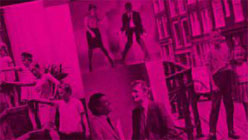For the aesthete, art books are the great democratizer. Without buying a piece of art (or even leaving your home), you can own a small, beautifully curated product. More and more, the art book is becoming its own medium, a skilled and beautiful form; going beyond mere reproductions of shows and collections, art books claim their own aesthetic and intellectual aims and value. On top of that, shelves of great books ratchet up your cultural capital (to quote John Waters, “We need to make books cool again. If you go home with somebody and they don’t have books, don’t f@*! them.”). The right art books, if kept in good condition, can prove a highly profitable investment. Picking only eight fall art books was difficult, as the offerings are vast and impressive. I have attempted to sample a range of kinds of artists and types of books. (For those visiting New York this weekend, be sure to attend the NY Art Book Fair (Sept 30 – Oct 2) at PS1 MoMA, which will host over 200 international booksellers, large and small.)
 1. Rodarte, Catherine Opie, Alec Soth
1. Rodarte, Catherine Opie, Alec Soth
Essay by John Kelsey
JRP|Ringier, September 30, 2011, 176 pages
As the title so clearly suggests, this shockingly beautiful book is a collaboration between two American fine art photographers (Catherine Opie and Alec Soth) and the fashion house Rodarte (comprised of the sisters Laura and Kate Mulleavy). It includes a provocative and experimental text by John Kelsey. Conceived of and executed with a surprising amount of freedom and openness, the book presents a new model for cultural collaboration between fashion, photography, and writing. The book itself is a meditation on landscape: the landscape of garments, of the California desert, of the body. Printed on heavy matte paper with rich color reproductions (and Kelsey’s text as an insert), it is as evocative and imaginative a project as I’ve seen in a while, and will likely sell out fast. Although this sampling is not hierarchical, there is a reason I put this book in the number one slot. I just bought it, and I can’t stop looking.
 2. Kippenberger: The Artist and His Families
2. Kippenberger: The Artist and His Families
by Susanne Kippenberger
J &L Books, Winter 2011, 500 pages
This book is the only one on the list to be released in Winter and not Fall, which almost led me to make the mistake of excluding it from this run-out-and-buy-it-or-at-least-go-look-at-it list. Published by J & L books, the non-profit publisher based in Brooklyn who always gets it right, this is an art book in the sense that it is about an artist. Rather than a survey of reproduced works, it is a comprehensive (500 pages) biography of the hard-drinking, confrontational, and hugely prolific German artist, written by his sister Susanne. Based on interviews with his family, friends, and professional colleagues, it promises a new, deeper insight into an artist who has influenced so many.

 3. The Unseen Eye: Photographs from the Unconscious
3. The Unseen Eye: Photographs from the Unconscious 4. It Chooses You
4. It Chooses You 5. Wolfgang Tillmans, Abstract Pictures
5. Wolfgang Tillmans, Abstract Pictures 6. Gerhard Richter: Panorama
6. Gerhard Richter: Panorama 7. Francesca Woodman
7. Francesca Woodman
